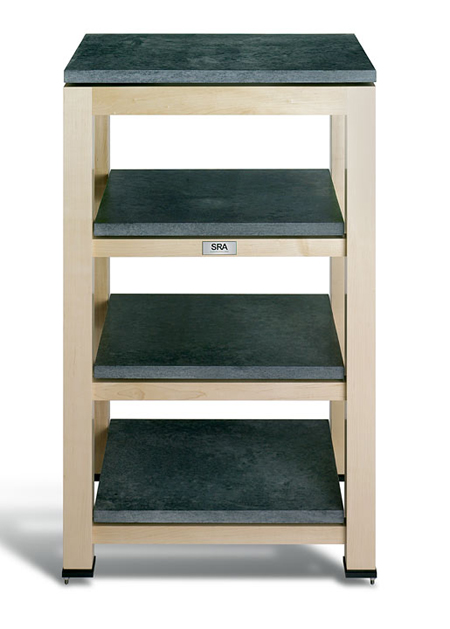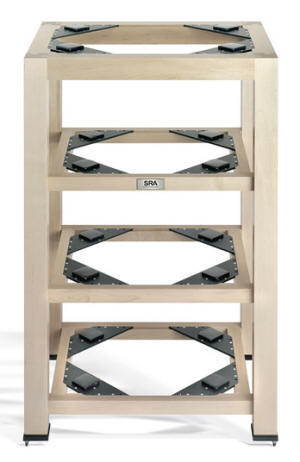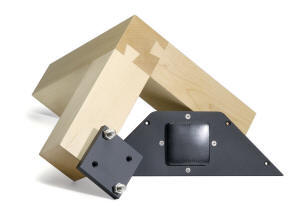You are reading the older HTML site
Positive Feedback
ISSUE
21
silent running audio
Craz isoRACK™ Reference Series - Form Meets Function
as reviewed by Myles B. Astor

|
MYLES B. ASTOR'S SYSTEM
LOUDSPEAKERS
ELECTRONICS
SOURCES
CABLES
ACCESSORIES
|
All high-end audio equipment designs are guided by the careful integration of form and function. For equipment racks, this means providing the resident audio equipment a home that is as vibration-free as humanly possible. Now this is no simple task. Audio equipment is bombarded by a diverse variety of multi-frequency vibrations emanating from airborne and ground-based sources—not to mention seismic activity directly traceable to the equipment itself. Nor does the vibration problem end there. Much of the vibration problem depends upon where you live (city or suburb, etc.), the type of floor in your home (for example, suspended vs. concrete), and where the equipment is situated relative to one's speakers or the room's structural components.
Unfortunately, for many high-end audio equipment stands "form" often appears to be an afterthought. Since many audiophiles' living rooms double as their listening room, a butt-ugly or cheap looking rack won't cut the mustard. Many companies have produced equipment racks that stop vibrations in their tracks, but belong in a garage or a workshop. Other units are worthy of display at the Museum of Modern Art, but the designers wouldn't know the difference between an earthquake and a footfall. (This is a lesser-known corollary of Holt's law that states the better the recording, the worse the performance, and vice versa). So the $64K question is why has it taken so long to achieve a balance between form and function for equipment racks?
Shape of Things to Come
Over the past few years, Silent Running Audio's equipment isolation bases and platforms garnered them a dedicated audiophile following (the late Lars Fredell first turned me onto SRA products). It was feedback from the same group of customers that was in large part responsible for the creation of the Craz isoRACK™ Reference Series. As designer Kevin Tellekamp recounts the story of the genesis of the Craz isoRACK™ Reference series, "We've received countless phone calls and emails from customers frustrated by their inability to find fully functional, aesthetically pleasing, true audiophile-grade equipment racks." The customers asked SRA, "Why not build an ultra-high-end audio equipment rack?" Two years later, the Craz isoRACK™ Reference Series was born.
Silent Running Audio's Craz isoRACK™ Reference Series is one of the few equipment stands successfully marrying both aesthetics and sound quality. There's no black metal stand sticking out like the black obelisk from 2001: A Space Odyssey. Couple the looks of the Craz isoRACK™ with its flexibility (a simple change of isopods to mate the shelves with any audio component) and this product from SRA will be a part of your audio system long after many other pieces of high-end audio gear are a distant memory.
First impressions make lasting impressions. The isoRACK™ is as sturdy as the proverbial Rock of Gibraltar (unlike other racks that I've played with). Each shelf weights from 50-70 pounds and serves to mass load the Craz's frame. No matter how much force is applied, there's no overcoming the inertia of the rack and setting it in motion. (That's even more amazing given the review isoRACK™'s 48-inch height.) Setting the rack up is a breeze—simply level the stand and then place each of the shelves atop the four black isopods. No design detail, no matter how small, was left to chance. Take for instance, shelf placement. To prevent nicking the isoRACK™'s delicate maple wood finish when slipping the equipment shelves into place, Tellekamp provides a 1/16-inch plastic protector that slips over the frame's maple legs.
By no means is the Craz isoRACK™ Reference series an off-the-shelf product. Each stand is built to accommodate each owner's specs and equipment. (See the "Technical Highlights" section below for further information.) This review sample came equipped with four equipment shelves (including a top shelf for an analog or digital turntable). My ultimate isoRACK™ is wider and shorter than the review sample—allowing the turntable and phono section to sit on the same shelf (save that the table will also be on a separate isolation base so as to minimize motor traceable vibrations)—thus reducing the tonearm lead length to a miniscule 13 inches.
Forming An Opinion
Once the equipment was unloaded, the old equipment rack moved out of the way, and the equipment replaced in the new rack, it was time for listening. This was one case where the sound was superlative from the moment the Lyra Titan touched the first groove—and unlike many other instances in my reviewing career, didn't lose its luster with time. The sonic improvements wrought by the insertion of the Craz Reference isoRACK™ were reminiscent of those engendered by the incorporation of high tech air platforms. (Bear in mind that air isn't quite the isolator it's cracked up to be; otherwise, speakers wouldn't work.) These included, greater bass extension, tighter and cleaner bass, a lowered noise floor resulting in increased overall low level resolution and greater transparency, and increased instrumental focus. As many audiophiles know and have experienced, improving and cleaning up the low end benefits musical reproduction elsewhere in the audio spectrum, these enhancements ranging from harmonic integrity and transparency to cleaner midrange.
The isoRACK™ transformed low frequency reproduction in my listening room. For the longest time I've been frustrated by the quality and quantity of the bass in my audio system. Since moving to my new digs two years ago, I've worked tirelessly to improve the bass, without great effect. Nothing I did—from moving the speakers to trying different cables—worked. Records and CDs that I was very intimately familiar with, such as Sounds of Rhythm (Top Music TMCD 1026) lacked that lowest octave of response—not to mention macrodynamics, clarity and attack. (Later I remembered I had substituted an old pair of Simply Physics for the original Sound Anchors tiptoes and that may have affected the low end response of the Sound Anchors stand. That said, the Sound Anchors, even in its best day, never approached the low end response of the Craz.)
As it turns out, it wasn’t the cables, room acoustics, etc. but the equipment stand that was responsible for the aforementioned bass problems. Specifically, it seems that the bass problem stemmed from conrad-johnson’s ART preamplifier’s being particularly sensitive to vibrations. (Interestingly, that’s despite the ART having a suspended circuit board.) That conclusion resulted from realizing that only the ART preamplifier sat in the Craz rack when listening to the digital front-end. With the Craz isoRACK™, the large drum on Sounds of Rhythm now explodes with a thunder, fervor and depth never before experienced. The large drum is far tighter and more dynamic—without any evidence of overdamping that’s so commonly encountered with other isolation devices. In addition, the drum’s size and internal resonance and cavity size are far more realistic sounding.
The isoRACK™ also changed my estimation of the VPI Scoutmaster turntable (soon to become the Super Scoutmaster plus Signature arm). In my VPI review, I noted that the bass response wasn't up to the sonic standards set elsewhere. That's no longer the case when perched atop the isoRACK™. Now the Scoutmaster's bass response is far more extended than I had thought initially. In addition, there's a far lower noise floor, coupled with a better transient response and dynamics throughout the frequency spectrum. The VPI Scoutmaster turntable definitely rates another half to full star, and is one of the greatest steals in audio today.
Vengeance with a Purpose
With continued listening, I had a nagging feeling that something was missing from the music. Many times this is a warning sign of the stand being subtractive in the midrange—or attenuating the upper frequencies. Some may think that the stand lies slightly to the lean side of neutral—but bear in mind that the system may need to be rebalanced once the isoRACK™ is placed into the system. I've concluded that what is actually missing is the grunge commonly mistaken for a false sense of ambience and harmonic integrity. Suddenly—as with the unreal recording of Messiaen's Chronochromie (Argo ZRG 756)—there's a greater sense of instrumental separation and spaciousness. Percussive instruments are far more extended and delicately rendered. On reference albums such as Picaflor (Titanic Mn-5), the lowered noise floor allows the listener to hear the subtlest of details, down the sense of actually hearing the guitar and mandolin through the pickup pattern of the microphones employed in the recording session.
Perhaps the isoRACK™'s most outstanding quality is its linearity and octave-to-octave coherency. Other isolation products such as cones, stands, platforms, etc. all have distinct colorations. Some may roll off the upper octaves. Some may boost the midrange. Some may seem to increase transient response. But in the end, it's often a case of whether the cure is worse than the disease. The isoRACK™ on the other hand, exhibits a sonic neutrality and consistency from top to bottom that that allows the sound of the components, warts and all, to shine through.
A Marriage Made in Heaven
If you think your high-end audio system is immune to the deleterious effects of vibrations, think again. It's obvious that sound of source components (analog turntables and SACD/CD players) and tube electronics (especially phono stages), are particularly sensitive to vibrations. Perhaps less obviously affected—but no more immune to this problem—is solid-state gear, including amplifiers at the other end of the audio chain. Don't assume that owning solid-state gear frees you from having to deal with isolation—not true!
Whatever pieces of equipment you own, Silent Running Audio's Craz isoRACK™ is an essential ingredient in the sonic mix. For many reference-quality high-end audio components, the Craz isoRACK™ will add up to an extra star to their perceived performance. Not only does this well-made and beautiful-looking stand bring the listener one huge step closer to the music, but the isoRACK™ lets one forget they are listening through the equipment. If you can, give this stand an audition—but be prepared, because once you've heard the SRA, it'll be hard to go home without one!
 Technical Highlights
Technical Highlights
Designer Kevin Tellekamp took a total system approach in designing the Craz isoRACK™. Every component used in the construction of the Craz isoRACK™ frame, footers, pods and shelves, aid in eliminating sonic anomalies over the broadest possible bandwidth at the highest possible amplitude. To reach this lofty goal, Tellekamp drew on his extensive knowledge of psychoacoustics, electrical, mechanical and chemical engineering, and the knowledge (some from many still classified design and test methods) developed by his sister company, Performance Coatings and Consultanting (PCC). (Among PCC's projects are supplying isolation products to the armed forces and NASA.)
isoRACK™ Frame
The isoRACK™'s frame is fashioned from 15 year-old, air-dried Maple wood joined together using the finest oversize dovetail and mortise and tenon joinery. According to the designer, "This method of fastening the vertical and horizontal wood pieces was chosen for its combination of rigidity and strength. Other construction methods," Tellekamp points out, "fatigue and have severe seismic problems at their connection points."
In addition, the isoRACK™'s wood frame is internally dampened with specially designed vertical and horizontal titanium tubes. These titanium tubes form the first line of defense in attenuating all but the most extreme low frequency frequencies from reaching the audio equipment. Viscous dampening materials inside each tube (each rack's dampening materials are specifically selected for each situation) combined with changing tube diameter work together to dissipate undesirable vibrations.
Footer Assembly
Four easily adjustable footers are located under each of the isoRACK™'s legs. Only a small portion of the footers actually contacts the leg; in turn, very high-pressure fittings connect the footer to the internal titanium rods. Typically, low frequencies are picked up at the footer level, passed into the tube assembly and dissipated as it passes through a series of viscous dampening materials.
 Equipment Shelves and Isopods
Equipment Shelves and Isopods
The Craz's equipment shelves are constructed from a proprietary nano-particle material that attenuates vibrations within a very specific frequency range. Four black hybrid isopods (fashioned from a combination of acrylic and thermal reactive urethanes stable over a wide range of temperatures and humidity) located in each corner of the wood frame support each shelf. These isopods are very load and application specific; consequently, different situations and audio equipment demand different isopods. Which isopod employed depends upon a variety of factors including equipment typography (loading, size of shelves, equipment specifics such as the component's resonances and weight) rack size, listening room specifics (suspended vs. concrete floors) etc. Changing audio components necessitates swapping isopods.
Fortunately, this is an easy task, requiring only a call to SRA. After receiving the replacement isopods, the owner removes the stainless steel fasteners, swaps out the old isopod, and then retightens the stainless steel fastener. This is all of a ten minute or less job (depending on whether or not one has an electric screwdriver!).
Silent
Running Audio Craz isoRACK™ with four shelves
Retail:
$7250
Frame:
Hard white Maple
Options:
mahogany; other woods available upon request
Dimensions: 48 x 30 x 22 inches (h x w x d)
Weight:
Without shelves, approximately 100 pounds; with shelves, approximately
250 pounds
Individual shelves range from 50 to 75 pounds, depending on thickness
Silent
Running Audio
325
Hubbs Ave.
Hauppauge, NY 11788
TEL:
631. 342. 0556
web address:
www.silentrunningaudio.com
Manufacturer's Response
I'd like to thank Positive Feedback Online for the posting and Myles Astor for his thoughtful review. Permit me to comment on an item or two.
The Craz Reference isoRACK plus is the most flexible equipment rack on the market. This is a matter of fact based on laboratory tests, not one man's opinion. Each build takes place with an eye to a lifetime of exactitude and usefulness. No aspect of the Craz Reference isoRACK plus is left to chance––none. In effect this means:
The customer need never install foam pads, pucks or anything else of that nature in order to optimize set-up. The customer has purchased what he or she believes to be the best and that's what we deliver: an infinitely flexible, factory-exact rack, irrespective of component, environment, or time in service.
Each Craz unit's design and construction address the customer's exact requirements. Our dedication to this principle involves custom-construction of all key elements, based on Craz size and other criteria. These key elements are modified as needed, according to data modeled by our software programs. This process confirms optimal set-up before construction begins. Simply put, every part of a Craz unit is virtually tested in our lab prior to fabrication.
Myles touches on an important point: our Isopod. The Isopod is at the heart of our Mass-Load Support System. In order to maintain exactitude––in other words, in order to relieve the customer of the need for guess-work, we offer a free, lifetime exchange of Isopods in the event that the customer opts for different gear or a change in listening environments. The Isopod is custom-designed to a specific application. Should that application change, new Isopods are delivered within, at the very most, forty-eight hours––at no cost to the customer. By this simple expediency, Craz remains perfectly tuned to its role in the system. Guess-work is never involved.
Competing products promise more than they deliver. Furthermore, with expensive "upgrades" taken into account, they are nowhere near as reasonable as the meticulously constructed, endlessly flexible Craz. Craz ships in one iteration. Craz requires no upgrades. Change components and replacement Isopods arrive post-haste. In terms of sound and a way of doing business, it's an impossible system to better, or beat.
Thanks,
Tim Miller
Engineer / Marketing
Silent Running Audio Inc
